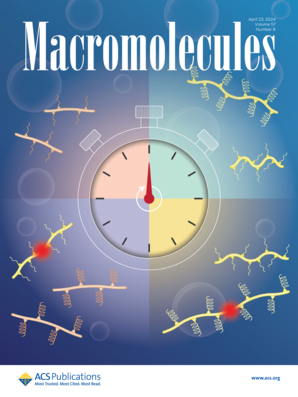双连续网络纳米结构的无溶剂超离子聚合物导体
IF 5.1
1区 化学
Q1 POLYMER SCIENCE
引用次数: 0
摘要
在传统的离子导电聚合物中,锂离子的输运与聚合物链的节段运动密切相关。由此导致的室温离子电导率和机械强度的严重不足,要求开发超离子导体,使锂离子的电导率与聚合物节段弛豫脱钩。在这里,我们展示了一种基于聚丙烯腈(PAN)接枝铁电聚偏氟乙烯(PVDF)(即PVDF-g-PAN)的简单高效的超离子锂导体体系。通过微相偏析,构建了双连续的网状纳米结构。铁电PVDF网络不仅具有高介电常数,有利于高浓度锂盐的解离,而且与氟化阴离子强烈相互作用,提高锂转移数(>0.6)。具有丰富的极性腈基和高玻璃化转变温度的pan -富网络作为Li+跳变通道,具有高离子电导率(5.8 × 10-4 S cm - 1,30°C),低活化能(0.21 eV)和优异的机械强度(200 MPa)。特别是,实现了几乎无溶剂的条件,使离子导电性能长期稳定。本文章由计算机程序翻译,如有差异,请以英文原文为准。

Solvent-Free Superionic Polymer Conductors from a Bicontinuous Network Nanostructure
In traditional ion conducting polymers, the lithium-ion transport is strongly coupled with segmental motion of a polymer chain. The resulted severe weakness of room-temperature ion conductivity and mechanical strength necessitates the development of superionic conductors, which decouple lithium-ion conduction from polymer segmental relaxation. Here, we demonstrate a simple and efficient superionic lithium conductor system based on polyacrylonitrile (PAN)-grafted ferroelectric poly(vinylidene fluoride) (PVDF), i.e., PVDF-g-PAN. A bicontinuous network nanostructure is constructed through the microphase segregation. The ferroelectric PVDF network not only presents a high dielectric constant, facilitating dissociation of high-concentration lithium salts, but also strongly interacts with fluorinated anions to enhance the lithium transference number (>0.6). The PAN-rich network with abundant polar nitrile groups and high glass transition temperature serves as the Li+ hopping channels, enabling high ion conductivity (5.8 × 10–4 S cm–1, 30 °C), low activation energy (0.21 eV), as well as excellent mechanical strength (>200 MPa). In particular, a nearly solvent-free condition is realized, enabling long-term stability of ion conducting performance.
求助全文
通过发布文献求助,成功后即可免费获取论文全文。
去求助
来源期刊

Macromolecules
工程技术-高分子科学
CiteScore
9.30
自引率
16.40%
发文量
942
审稿时长
2 months
期刊介绍:
Macromolecules publishes original, fundamental, and impactful research on all aspects of polymer science. Topics of interest include synthesis (e.g., controlled polymerizations, polymerization catalysis, post polymerization modification, new monomer structures and polymer architectures, and polymerization mechanisms/kinetics analysis); phase behavior, thermodynamics, dynamic, and ordering/disordering phenomena (e.g., self-assembly, gelation, crystallization, solution/melt/solid-state characteristics); structure and properties (e.g., mechanical and rheological properties, surface/interfacial characteristics, electronic and transport properties); new state of the art characterization (e.g., spectroscopy, scattering, microscopy, rheology), simulation (e.g., Monte Carlo, molecular dynamics, multi-scale/coarse-grained modeling), and theoretical methods. Renewable/sustainable polymers, polymer networks, responsive polymers, electro-, magneto- and opto-active macromolecules, inorganic polymers, charge-transporting polymers (ion-containing, semiconducting, and conducting), nanostructured polymers, and polymer composites are also of interest. Typical papers published in Macromolecules showcase important and innovative concepts, experimental methods/observations, and theoretical/computational approaches that demonstrate a fundamental advance in the understanding of polymers.
 求助内容:
求助内容: 应助结果提醒方式:
应助结果提醒方式:


